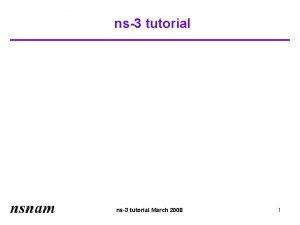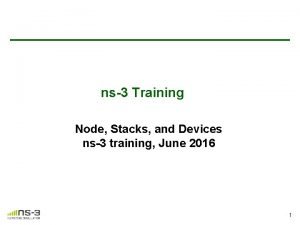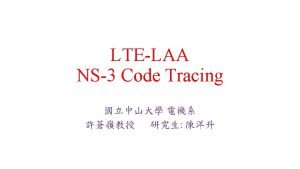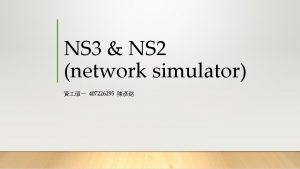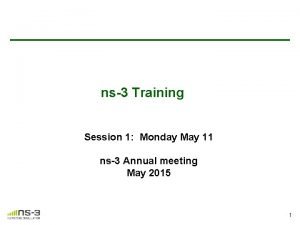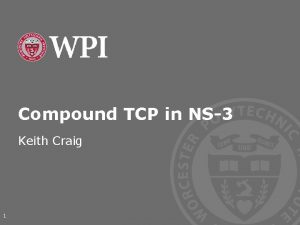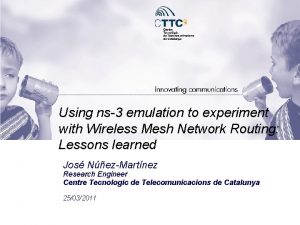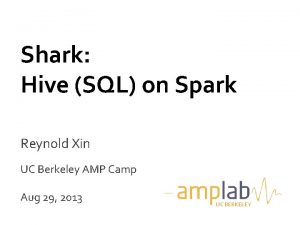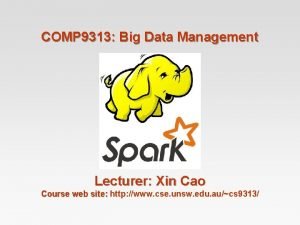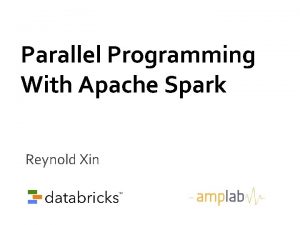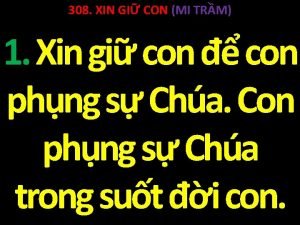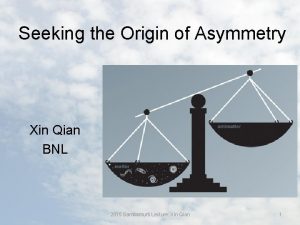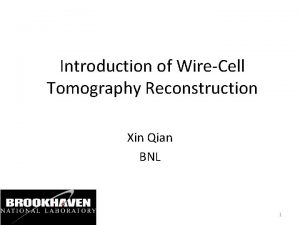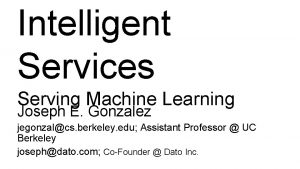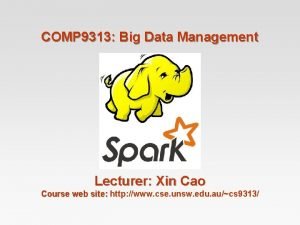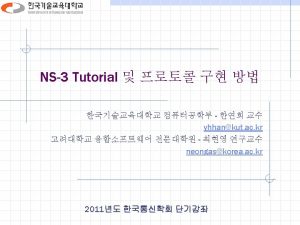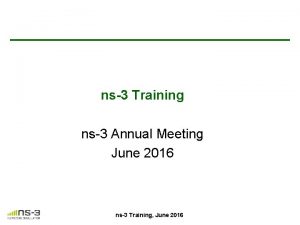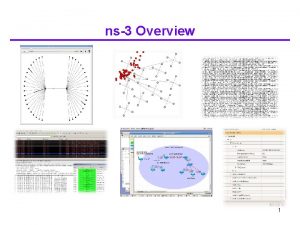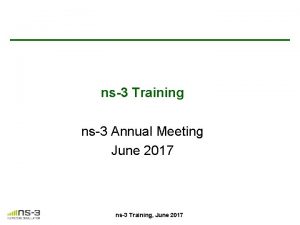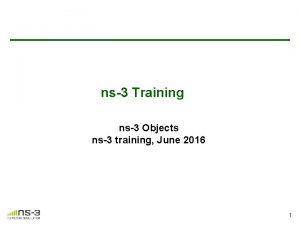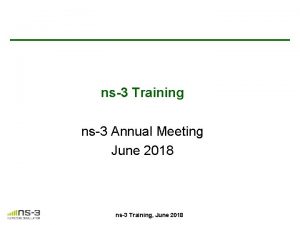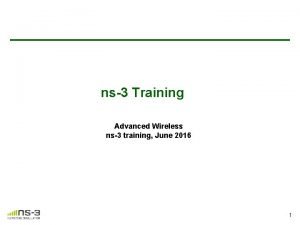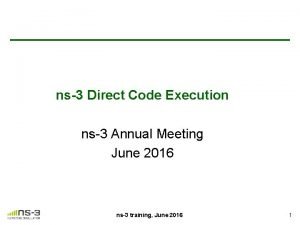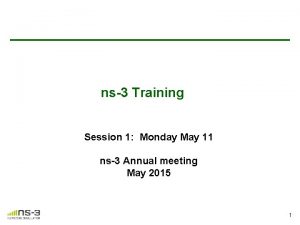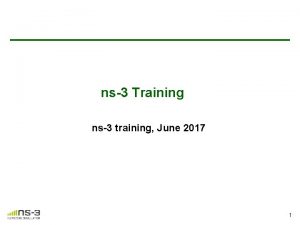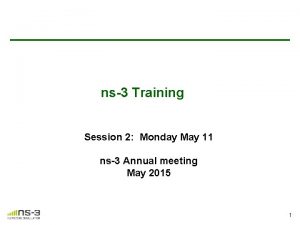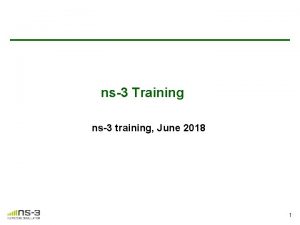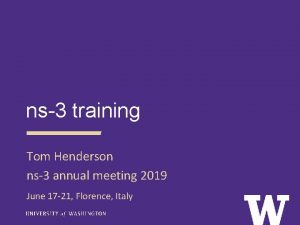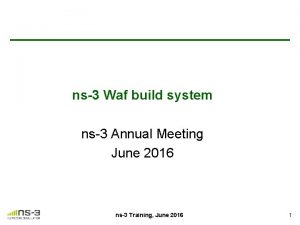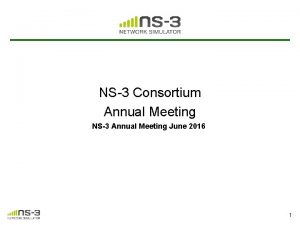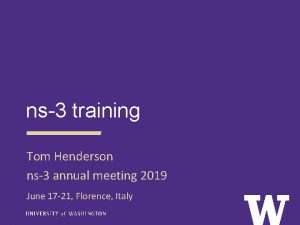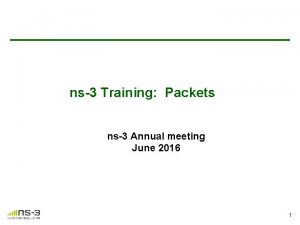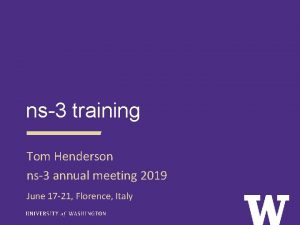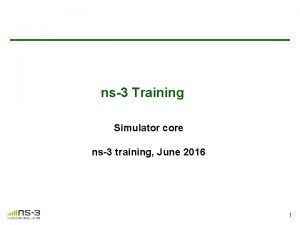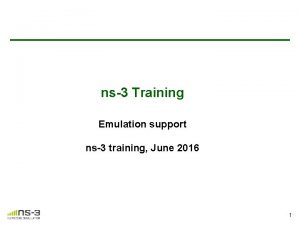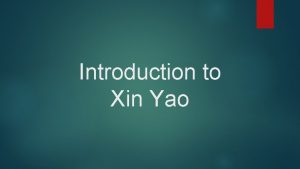NS3 TUTORIAL Xin Li Introduction What is ns3















![NS-3 Build ■ For those familiar with autotools: – configure ->. /waf -d [optimized|debug] NS-3 Build ■ For those familiar with autotools: – configure ->. /waf -d [optimized|debug]](https://slidetodoc.com/presentation_image_h/1e8b4486b61f06b08ba64659fb312354/image-16.jpg)













- Slides: 29

NS-3 TUTORIAL Xin Li

Introduction

What is ns-3? ■ ■ ■ Network Simulator Version 3 Software simulated models Discrete-event simulator Written in C++/Python binding Focus on packet level Wired/Wireless

Why ns-3? ■ Simulation V. S. Testbed – Reproducibility – Ease of deployment – Investigate non-existed systems – Scalability ■ Ns-3 V. S. other simulation tools – Community-oriented – Free and open-source – Ease of debugging

Setup

Installation ■ Instructions – https: //www. nsnam. org/wiki/Installation ■ Supported systems – Linux – Mac. OS – Free. BSD – Windows Linux through virtual machine

Development Environment ■ IDE – Eclipse – QT Creator – Net. Beans ■ Text editor + command line

Models

The Basic NS-3 Data Flow Model Application Protocol stack Application Sockets-like API Protocol stack Packet(s) Node Net. Device Node Channel Net. Device

NS-3 Models: Node & App ■ Nodes – End-Systems, Routers, Hubs, NATs ■ Applications – Bulk TCP transfer – TCP/UDP “On-Off” application – Web browsing – Peer-to-peer file transfers – Video streaming – Chat

NS-3 Models: Protocol Stack ■ TCP-UDP-IPV 4 -IPV 6 ■ Routing Protocols – BGP – OSPF – EIGRP – OLSR – DSR – AODV ■ Multicast Protocols – PIM-SM/DM - DVMRP

NS-3 Models: Net Device & Channel § Net Devices & Channels bound Wifi. Channel Wifi. Net. Device

NS-3 Models: Net Device & Channel ■ Network Interfaces – Wired/Wireless – Layer 2 protocols 802. 3, 802. 11 ■ Channel – Ethernet (10/1000 Mb) – Point-to-Point – Wireless ■ Mobility Models – Random Walk – Specific Waypoint - Swarming

Usage

NS-3 Modules API: https: //www. nsnam. org/doxygen/
![NS3 Build For those familiar with autotools configure waf d optimizeddebug NS-3 Build ■ For those familiar with autotools: – configure ->. /waf -d [optimized|debug]](https://slidetodoc.com/presentation_image_h/1e8b4486b61f06b08ba64659fb312354/image-16.jpg)
NS-3 Build ■ For those familiar with autotools: – configure ->. /waf -d [optimized|debug] configure – make ->. /waf – make test ->. /waf check (run unit tests) ■ Can run programs through a special waf shell –. /waf --run simple-point-to-point 16

Network Simulation Flowchat ■ Create topology – Nodes, Links, Queues, Routing, etc. ■ Create data demand on network – Web browsers, FTP transfers ■ Run simulation ■ Analyze results

Smart Pointers ■ ns-3 objects are memory managed by a reference counting smart pointer implementation ■ Easier memory management ■ Treat a smart pointer like a regular pointer

Attributes ■ Changing objects' characteristics ■ Member Function ■ Config System

Random Variables ■ Currently implemented distributions – Uniform, Poisson Process, etc. ■ Usage

Callbacks ■ Allow one piece of code to call a function without any specific inter- module dependency ■ Example:

Timing and Schedule ■ Time is not manipulated directly: the Time class ■ Example:

Logging ■ ns-3 provides a selectable, multi-level approach to message logging ■ Logging can be – disabled completely – enabled on a component-by-component basis – enabled globally

Logging ■ Seven levels of log messages of increasing verbosity: NS_LOG_ERROR NS_LOG_WARN NS_LOG_DEBUG NS_LOG_INFO NS_LOG_FUNCTION NS_LOGIC NS_LOG_ALL ■ Each level can be requested singly or cumulatively

Logging § Example: § Enable outside code:

Tracing ■ Tracing Changes – Producer Consumer Pattern

Tracing ■ Helper – Connecting source and sink

Visualization ■ Live visualization with Py. Viz

Useful Resources ■ NS-3 Wiki Page – https: //www. nsnam. org/wiki/Main_Page ■ NS-3 Tutorial – https: //www. nsnam. org/docs/tutorial/html/ ■ NS-3 API Document – https: //www. nsnam. org/docs/release/3. 17/doxygen/index. html
 Ns3 tutorial
Ns3 tutorial Ns3 tutorial
Ns3 tutorial Ns3 training
Ns3 training Fdd frequency division duplex
Fdd frequency division duplex Ns3 network simulator
Ns3 network simulator Ns3 training
Ns3 training Cubic vs ctcp
Cubic vs ctcp Ns3 training
Ns3 training Reynold xin
Reynold xin Con xin dâng lên muôn lời suy tôn
Con xin dâng lên muôn lời suy tôn Con thờ lạy hết tình
Con thờ lạy hết tình Lạy cha xin tha cho họ
Lạy cha xin tha cho họ Một người ăn xin đã già
Một người ăn xin đã già Comp9313
Comp9313 Funeral banner of lady dai
Funeral banner of lady dai Xin cho lòng chúng con
Xin cho lòng chúng con Slidetodoc.com
Slidetodoc.com Con xin tiến dâng rượu bánh nơi nương đồng
Con xin tiến dâng rượu bánh nơi nương đồng Reynold xin
Reynold xin Maranatha, lời nguyện thiết tha
Maranatha, lời nguyện thiết tha đông qua mau trúc xinh nghiêng nghiêng đợi chờ
đông qua mau trúc xinh nghiêng nghiêng đợi chờ Lạy chúa chí tôn xin dủ tình xót thương con
Lạy chúa chí tôn xin dủ tình xót thương con Xin giữ con để con phụng sự chúa
Xin giữ con để con phụng sự chúa Xin qian bnl
Xin qian bnl Xin than linh den
Xin than linh den Wirecell
Wirecell Joseph e. gonzalez
Joseph e. gonzalez Comp9313 unsw
Comp9313 unsw Slidetodoc.com
Slidetodoc.com Xin giấu con nơi cánh tay cha
Xin giấu con nơi cánh tay cha

